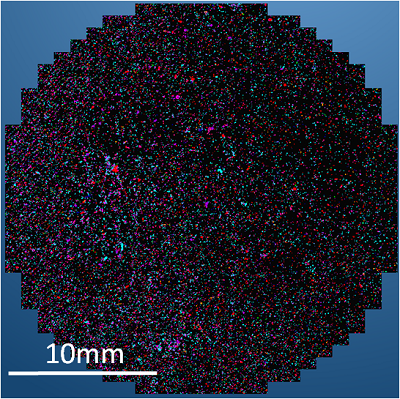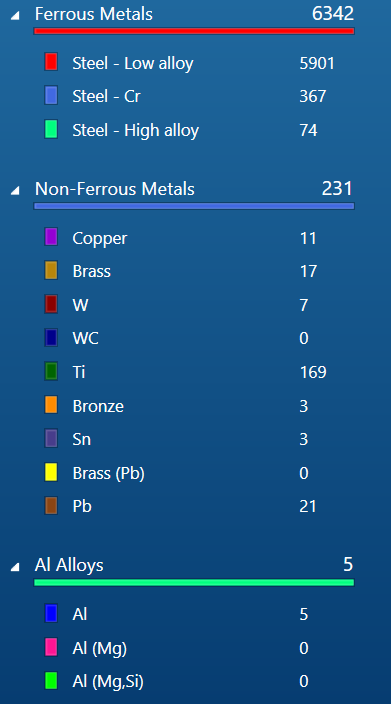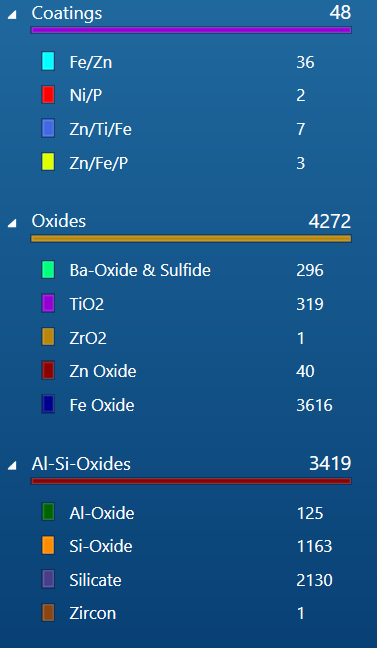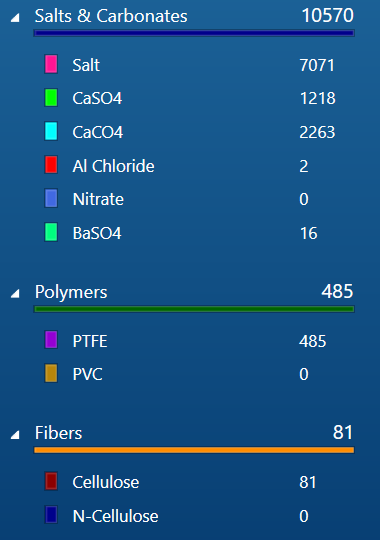产品
FIB-SEM
Nanomanipulators
OmniProbeOmniProbe Cryo软件
AZtec3DAZtecFeatureAZtec LayerProbeTEM
Hardware
EDSUltim MaxXploreImaging
软件
AZtecTEM
AZtecClean在 AZtecFeature 颗粒物分析平台上,根据清洁度分析的特点,内置了相应的分类方法和国际标准。它可以自动检测、识别符合ISO 16232和VDA 19等国际标准的颗粒,并导出这些颗粒的汇总报告,报告格式符合标准要求。
AZtecClean能够保证所有的颗粒都能被快速、轻松和准确地分析,其结果可以帮助确定污染物的来源和制定适当的补救措施。
AZtecClean使用牛津仪器 Ultim Max 或 Xplore 系列能谱仪和 ZtecLive Tru-Q 算法,能够确保在高通量的快速颗粒物检测中的高水准元素识别和定量,保证检测结果的可靠性。

使用AZtecClean自动检测的整张滤纸上的颗粒
| Label | A | B | C | D | E | F | G | H | I | J | K |
| Class/Length (μm) | <5 | 5.0-15 | 15-15 | 25-50 | 50-100 | 100-150 | 150-200 | 200-400 | 400-600 | 600-1000 | >1000 |
| All Features | 1861 | 20852 | 9249 | 5795 | 1116 | 189 | 61 | 30 | 3 | 0 | 0 |
| Ferrous Metals | 148 | 2241 | 1628 | 1896 | 343 | 58 | 17 | 10 | 1 | 0 | 0 |
| Steel - Low alloy | 136 | 2063 | 1515 | 1781 | 326 | 53 | 16 | 10 | 1 | 0 | 0 |
| Steel - Cr | 11 | 143 | 100 | 96 | 12 | 4 | 1 | 0 | 0 | 0 | 0 |
| Steel - High alloy | 1 | 35 | 13 | 19 | 5 | 1 | 0 | 0 | 0 | 0 | 0 |
| Non-Ferrous Metals | 16 | 132 | 55 | 26 | 2 | 0 | 0 | 0 | 0 | 0 | 0 |
| Copper | 0 | 4 | 4 | 3 | 0 | 0 | 0 | 0 | 0 | 0 | 0 |
| Brass | 1 | 7 | 4 | 4 | 1 | 0 | 0 | 0 | 0 | 0 | 0 |
| W | 1 | 2 | 1 | 3 | 0 | 0 | 0 | 0 | 0 | 0 | 0 |
| Ti | 12 | 107 | 34 | 15 | 1 | 0 | 0 | 0 | 0 | 0 | 0 |



预置的清洁度分类方法可以识别并分类常见颗粒,分类方法支持自定义
使用AZtecClean对清洁度分析进行高效、快捷地参数设置和数据采集。
By utilising FeaturePhase to analyse the saturated particle (A), it is possible to determine that two phases (steel & silicate) are present within the particle (B).
 公安机关备案号31010402003473
公安机关备案号31010402003473